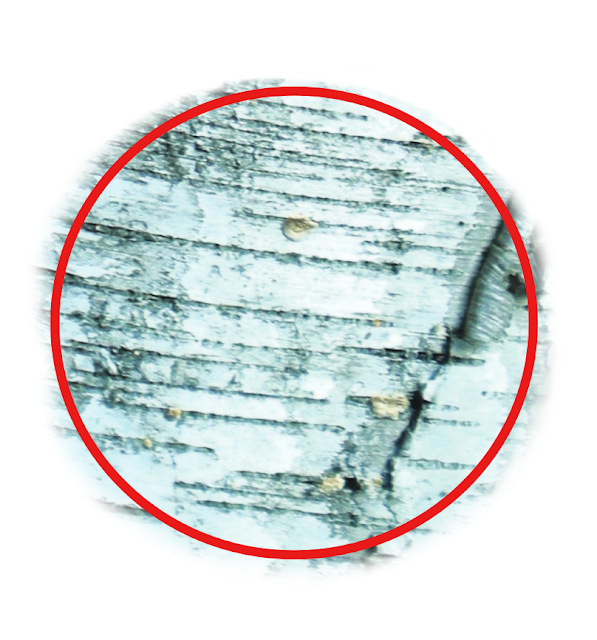One hot afternoon, C and I were lazing in the pool. C, studying a nearby birch, came up with a curious concept. How cool it would be, she said, if the horizontal, parallel dark lines on the birch trunk were actually lines of type. "Well they are, darling", I replied and related an article I read in a chronicle that Bin had introduced to me.
This chronicle, the Empheris Felidae, was written by a mysterious man in New York City named Malichi. While mainly a record of feline history and their impact on humans, there are also bits of esoterica concerning other species. It is here that I read an astonishing article about birches and their ability to write.
 |
| A birch trunk |
 |
| A closer view showing the lines |
In 1894, Swedish botanist Per Karl Hjalmar Dusén (1855-1926) was investigating a new and devastating disease that was decimating the birch population in the northern areas of Scandinavia and Russia. One day he was looking at a piece of bark under his new and quite powerful microscope. He was astounded to see within the dark horizontal lines, what looked to be string of symbols. Unable to further magnify with his microscope, Dusen went to the Karolinska Institute in Stockholm who possessed the most powerful instrument in the country. What he saw was mind-blowing:
Dusen immediately dispatched his assistants to collect more bark samples and contacted an old friend who retired from military intelligence as a code-breaker. "Could you take a look at something?" Dusen asked and his friend agreed. Not revealing the source, Dusen showed a transcription of the text he had found. "Ah" his friend said, "this is Elder Futhark script, maybe 550 AD. It's a rune used by our ancestors." "Are you sure?" stammered Dusen. "Oh yes, my dear boy. And by the way, that alphabet was translated some time ago." Dusen stood shocked, stunned. His friend took out his pen and notebook out of his jacket and began to write. "Go see Professor Nilsson at Uppsala University and he will translate this for you. My goodness Per, you look quite pale!"
His initial piece was translated and it was a piece of poetry. "An ode to the sun" Professor Nilsson said smiling. "Where did you find this? Runes from this period have never shown this level of sophistication." "Let's go for a drink," replied Dusen "I have a tale to tell you."
That meeting at the bar resulted in a partnership of study and in a matter of months they had collected translations of hundreds of runes with staggering revelations:
-there was a wide range of topics: some creative like the initial piece brought in by Dusen, manuals for living-techniques for weathering the climate, diseases, historical records.
-they found that some trees in a clump wrote on a similar topic, others were individualistic.
Two other avenues of investigation explored how their ancestors found, learned and used the rune and much more perplexing and theoretical: what was the purpose of the runes and did other species "read" them?
Dusen and Nilsson were so excited and focused on their discoveries that they hadn't considered that there might be a downside to their work or the need for secrecy. This was pure research and little thought was given to controlling information flowing out to the public. The press had picked up the story and generally treated it as an amusing example of outlandish fairy tales from silly academics. The Church, however, was deeply alarmed. The concept of such high intelligence from a non-human species threatened one of the cornerstones of the Christian narrative: the primacy of Man over all other creatures. Worries arose that tree worshipping cults would spring up and draw away the faithful. Church elders did not care to tolerate a rival to their unquestioned power and authority they enjoyed. In November 1896, the regional leaders of all main Christian sects met secretly in Copenhagen. A wide-ranging campaign of suppression and repudiation was developed to stamp out the ideas and research as well as crushing the reputation of Dusen and Nilsson. Church elders called upon their friends in government to apply additional pressure on the two men.
Malichi ends this narrative that his research found typical in human history: the Birch rune discovery was suppressed and the findings destroyed. A smear campaign to discredit both men was pursued with vigor. Dusen became an alcoholic and institutionalized for dipsomania. Professor Nilsson eventually committed suicide. Over the years most of their assistants died prematurely often under mysterious circumstances.
What does this all mean? One of the central ideas put forth by in the Empheris Felidae, is that all living creatures other than human can communicate with other species. Bin referred to this as "a really bad evolutionary joke." This odd deficit in humans, cats assert, as well as our arrogance and hubris, is one of the major sources of conflict and destruction on the planet. By enabling and aiding Malichi to document such concepts was an attempt by some in the feline community to help educate our species with the hope of modifying our behavior.
Scientists are slowly researching inter-species communication. I came across this article in the NYT about trees communicating via an underground network facilitated by fungi.
https://www.nytimes.com/interactive/2020/12/02/magazine/tree-communication-mycorrhiza.html
There is discussion of Indigenous myths that speak of forests communicating underground and the idea that "all things are connected." However, one mystery stands uninvestigated: how did humans learn of this communication or are the myths an example of campfire storytelling?


I love the way you've developed this in depth, and your recent theme of messages from the cosmos. Those stories alone would make a great book.
ReplyDelete